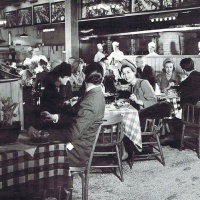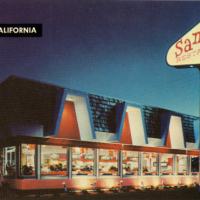
Most people wouldn’t think of ceiling treatments as significant elements of restaurant decor, but they have been in many cases, as I have touched upon in an earlier post. In the 19th and early 20th centuries, fancy restaurants borrowed palatial European ceiling treatments with molded plaster ovals and rectangles framing paintings of classical scenes.
Such ceilings were, of course, in the minority. Most restaurants kept it simple with plain wood, plaster, or acoustic tile. A common treatment was to expose part of the building’s structure, its ceiling beams. Over time, of course, most buildings were no longer constructed with wooden beams. Steel beams don’t convey quite the same thing, and are usually covered up. But, as one company that makes faux beams for restaurants writes, “A drab ceiling design can easily detract from the experience.”
This realization led some eating places to attach fake beams. Although they are meant to convey an impression of sturdiness, in at least one case that impression was tragically false. In 1993 a decorative beam that had been attached with too-short nails came loose from the ceiling in a newly opened Taco Cabana in Las Vegas. It injured 14 people and the restaurant closed.

Cover-ups. If beams are meant to reveal structure, many restaurants have tried instead to hide structure. As I researched this topic I was surprised to discover that collapsing ceilings are not entirely rare. This led me to wonder about one of the more common types of ceiling decor, billowing swaths of cloth. Was this merely a simple way to hide an unsightly or crumbling ceiling? Cloth ceilings certainly lacked the elegance borrowed from European palaces with rococo relief work and frescoed scenes, but they were undoubtedly much cheaper.
Hanging things. Objects dangling from ceilings may also simply be meant to add interest. They have ranged from faux flowers (Colaizzi’s), to enormous swordfish at a Texas fish restaurant (Granger’s, Sabine Pass TX), or grids of bamboo poles with Japanese glass float balls in Polynesian themed eateries. Maxwell’s Plum featured large animals in its street-front café. But none of these suspended objects could match those at Eddie Rickenbacker’s of 1980s San Francisco where the owner suspended his collection of vintage motorcycles.
Blue skies smiling above. In the 1930s it became popular to design a dining area to look as though it was located in a courtyard of a village, open to a starry sky above. This may have been a way of dealing with windowless interiors. In Los Angeles, the Paris Inn recreated a scene with the Eiffel Tower at one end, streetfront building alcoves along the sides, with tables under a starry sky between. The Child’s chain recreated Old France in Boston in the 1930s, while Morrison’s Cafeteria in New Orleans featured a Spanish pueblo. Blue sky ceilings had staying power. At El Fenix Restaurant of Casa Linda in Dallas in the 1950s guests were invited to “Dine in the Delightful Atmosphere of Old Mexico” where a large fake palm tree rose up incongruously from a checkered linoleum floor.

Lighted glass. When it comes to lighted glass ceilings, Maxwell’s Plum springs to mind immediately, with elaborate glass ceilings in both its NYC and San Francisco locations. But neon rods in a sunburst pattern could also be striking, especially when you consider that they were part of a drive-in’s decor. Of course California drive-ins, such as Dutch Youngman’s in Monterey shown here, were often more elaborate than those in the rest of the country.
There were certain hazards with a lighted glass ceiling, as I discovered at a restaurant in St. Louis.
© Jan Whitaker, 2020
















 It's great to hear from readers and I take time to answer queries. I can't always find what you are looking for, but I do appreciate getting thank yous no matter what the outcome.
It's great to hear from readers and I take time to answer queries. I can't always find what you are looking for, but I do appreciate getting thank yous no matter what the outcome.



I wonder about those tented ceilings and fires…
So do I. They’d go fast!
Great content 🙂 Thank you
I don’t know where you find these postcards and such, but I am always gobsmacked by your posts — such an appetizing little niche of the Internet you have created!
Thank you so much. I’ve been collecting them for a long time!
Two of our favourite Toronto restaurants have lovely ceilings. Alas, La Societe has closed, but you can find images of its stained-glass ceiling online. Cluny Bistro is still hanging in there. We hope to see it again one day!
Quite elegant!
Thanks Jan
And of course, here in Myamuh, the famed Jorgen Moeller-owned PRINCE HAMLET, at 81st or 82nd Street and Biscayne Boulevard had the wonderful “upside down table” hanging from the ceiling, a full-sized table, set as a complete four top with the china, silver and glassware all in their places. It really was unique. AND, folks, I will shortly let you know about the discount which I can arrange for us on the new LOST RESTAURANTS of MIAMI book, which, as I think previously noted, covers all of Greater Miami, not just the city of Miami. If you a Floridian or have an interest in club and restaurant history I think you will love it!
Clever. Looking forward to your book!